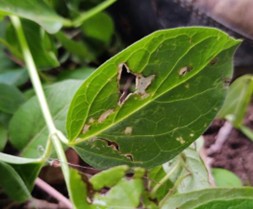Background. Both black (Vincetoxicum nigrum syn. Cynanchum louiseae) and pale swallowwort (Vincetoxicum rossicum syn. Cynanchum rossicum) are invasive plants in Connecticut. Members of the Apocynaceae family, these herbaceous plants native to Eurasia have no native enemies to keep their populations in check and, as a result, spread rampantly. A common name is “dog strangling vine”, which attests to the quick and profuse spread. Most problematic, the Apocynaceae family includes milkweeds (Asclepias spp.).
Swallowworts are closely related to milkweeds. Black and pale swallowworts outcompete our native milkweeds. In addition, monarch butterfly females do not sense the difference between swallowworts and native milkweed plants and will lay their egss on the swallowworts, which, unfortunately, will not support the development of monarch caterpillars.


Connecticut Presence. Black swallowwort is found in all counties in Connecticut except for Hartford County. Pale swallowwort grows in all Connecticut counties except for Litchfield and Hartford counties.
Control Methods. No natural enemies of black or pale swallowwort have been observed in North America. Deer will not eat either swallowwort species. Damaging fungal growth has been observed on swallowwort leaves but, at this time, little is known of this fungus and it is not a suitable control. Current management approaches for swallowwort include both chemical (herbicide) and mechanical/physical (pulling, mowing, digging) methods. Some pesticides are toxic to bees and other non-target insects. With increasing trends of non- chemical crop production and potential bans of pesticides in the future, biological control
will provide a sustainable and viable alternative. A successful biological control program may reduce the costs and environmental impacts of herbicide use and will provide a new tool to enhance management options for control of black and pale swallowwort.




Biological Control. Recognizing the problems posed by swallowwort in the landscape, in the 2000s, a Ph.D. student at the University of Rhode Island found several potential insect
controls during Eurasian research. Extensive lab tests led to the selection of the Hypena opulenta moth because the larvae (caterpillars) feed exclusively on swallowwort.
Subsequent lab work found that Hypena opulenta does not feed on native milkweeds. The moth was released in Canada in 2013. A US federal permit to release was issued in 2017 and moths were released in Rhode Island, New York, and Massachusetts, and, since 2019, in Connecticut.
After three years, the implementation of this biological control remains in an experimental state. Current efforts focus on adjustments to promote successful overwintering of the moths and building the populations at the release sites. This is by no means a general release biological control at this time.
Links to Additional Information on Biological Control of Swallowwort:
University of Rhode Island https://web.uri.edu/biocontrol/black-swallowwort/
University of Connecticut
Prepared by: Gail K Reynolds, 2021
Photos by: Gail K Reynolds, 2020 and 2021
The information in this document is for educational purposes only. The recommendations contained are based on the best available knowledge at the time of publication. Any reference to commercial products, trade or brand names is for information only, and no endorsement or approval is intended. UConn Extension does not guarantee or warrant the standard of any product referenced or imply approval of the product to the exclusion of others which also may be available. The University of Connecticut, UConn Extension, College of Agriculture, Health and Natural Resources is an equal opportunity program provider and employer.